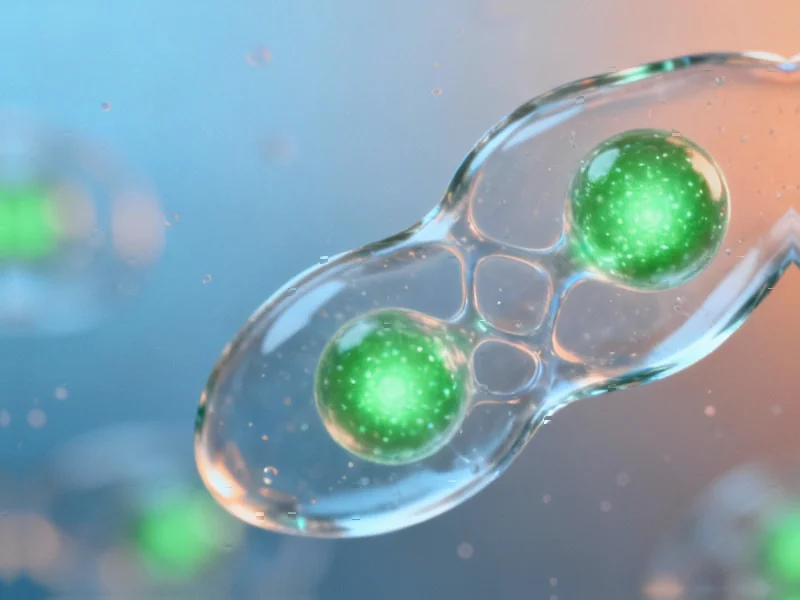Breakthrough Imaging Technique Reveals Embryonic Development Secrets
Scientists have successfully developed an advanced method for live-imaging human embryos that reveals previously unseen cell division errors, according to a new study published in Nature Biotechnology. The research team optimized nuclear DNA labeling techniques that allowed them to track embryonic development for up to 48 hours without disrupting normal growth patterns. Sources indicate this represents a significant advancement in understanding early human development.
Table of Contents
- Breakthrough Imaging Technique Reveals Embryonic Development Secrets
- Methodology Development Through Extensive Testing
- Advanced Imaging Reveals Critical Differences
- Unexpected Mitotic Errors Discovered
- Micronuclei Fate and Cellular Consequences
- Cell Lineage Tracking Developments
- Research Implications and Future Directions
Methodology Development Through Extensive Testing
Researchers initially systematically investigated various labeling methods using mouse embryos, the report states. They compared multiple approaches including lentivirus, adeno-associated virus, baculovirus, DNA dyes, and mRNA electroporation. Analysis showed that viral methods suffered from gene silencing or transient expression, while DNA dyes produced inconsistent results across different cell types.
The team ultimately identified mRNA electroporation as the most effective method, with sources indicating approximately 75% efficiency in mouse embryos and 41% in human embryos. This technique allowed chromosome labeling without significant impact on development to the blastocyst stage, according to the findings.
Advanced Imaging Reveals Critical Differences
Using light-sheet microscopy with dual illumination and double detection capabilities, researchers captured detailed views of embryonic development. The study revealed that while mitotic duration was similar between mouse and human embryos—approximately 50 minutes—significant differences emerged in interphase timing. Analysis showed human embryos exhibited substantially longer interphase periods, averaging 18-19 hours compared to 10-11 hours in mouse embryos.
This interphase timing difference may be a key factor in setting the pace of preimplantation development across species, analysts suggest. The extended interphase in human embryos provides more time for cellular processes before division, potentially contributing to developmental differences observed between mammalian species.
Unexpected Mitotic Errors Discovered
The high-resolution imaging enabled researchers to identify various chromosomal segregation errors in blastocyst-stage human embryos. According to the report, misaligned chromosomes were observed in 8% of human cells compared to 4% in mouse cells. These included lagging chromosomes and micronuclei formation exclusively during mitosis rather than interphase.
Researchers documented several rare but significant events, including what sources describe as “mitotic slippage” where cells prematurely exit mitosis without proper chromosome segregation, resulting in tetraploid cells. The study observed this phenomenon in 2 of 223 human embryo cell divisions. Additionally, analysts reported observing de novo multipolar cell divisions in human embryos, where spindle formation during anaphase produced three daughter cells instead of the typical two.
Micronuclei Fate and Cellular Consequences
The study provided new insights into the behavior of micronuclei—small separate nuclei that form when chromosomes or chromosome fragments are not incorporated into the main nucleus during cell division. Tracking revealed that the majority of micronuclei (89% in human and 93% in mouse) persisted in the cytoplasm without fusing with the primary nucleus.
Notably, the research showed that cells containing these chromosomal abnormalities remained viable and continued to proliferate. According to the findings, daughter cells from divisions with misaligned chromosomes underwent at least one additional round of cell division, suggesting these cells avoid immediate death despite severe mitotic errors.
Cell Lineage Tracking Developments
Researchers developed a semi-automated nuclei segmentation method using a customized deep learning model to track individual cell positions in developing embryos. The technology allowed precise monitoring of cell migration and fate determination during critical developmental stages.
In human embryos, analysis showed that outer trophectoderm cells generally remained in their positions and produced more trophectoderm cells. However, in one notable case, researchers observed a single cell that divided with one daughter cell remaining outside while the other migrated inward, suggesting some positional flexibility even at later developmental stages.
Research Implications and Future Directions
The findings provide unprecedented insight into early human development and the origins of chromosomal abnormalities. According to analysts, the observed mitotic errors—including misaligned chromosomes, multipolar divisions, and mitotic slippage—likely contribute to mosaic aneuploidy in developing embryos.
This research establishes a foundation for better understanding early embryonic development and may eventually inform improvements in assisted reproductive technologies. The developed imaging and tracking methodologies represent significant technological advancements that could enable future studies of embryonic development with minimal disruption to natural processes.
Related Articles You May Find Interesting
- Helsinki’s Donut Lab Strengthens E-Mobility Ecosystem with Nordic Nano Partnersh
- PS5 Achieves Historic US Sales Milestone, Surpassing PlayStation 3 Lifetime Figu
- SAP Secures 85% of 2026 Revenue Pipeline as AI Deals Accelerate
- Corporate Leaders Outpace Workforce in AI Adoption, Creating Workplace Tensions
- The Unseen Data Crisis Derailing Industrial AI Deployments
References
- http://en.wikipedia.org/wiki/Micronucleus
- http://en.wikipedia.org/wiki/Transduction_(genetics)
- http://en.wikipedia.org/wiki/Cleavage_(embryo)
- http://en.wikipedia.org/wiki/Trophoblast
- http://en.wikipedia.org/wiki/Interphase
This article aggregates information from publicly available sources. All trademarks and copyrights belong to their respective owners.
Note: Featured image is for illustrative purposes only and does not represent any specific product, service, or entity mentioned in this article.



